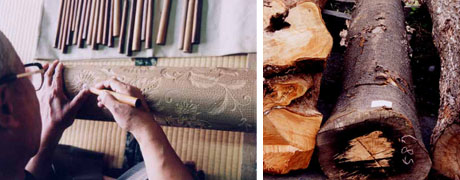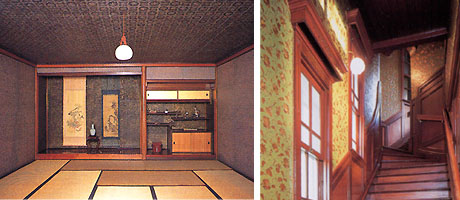
 |
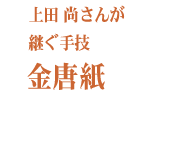 |
Takashi Ueda's Kinkarakami
Takashi Ueda's quest to carry on the craft of gold-embossed wallpaper
|
Mr Takashi
Ueda first came to know of the craft called Kinkarakawakami (gold-embossed
wallpaper) 19 years ago in 1983. It was at a paper museum in Hachioji,
Tokyo, one of the birthplaces of Japanese paper. What he discovered
there were wooden rollers made from single blocks of cherry wood
into which had been carved intricate arabesque and other designs.
These rollers were for the woodblock decoration of wallpapers that
were made in Japan to mimic gold-embossed calf-skin wall coverings
from Europe. |
||
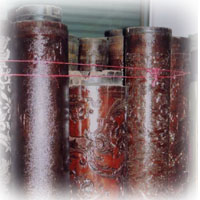 |
The craft so captivated Mr Ueda that he immediately ended his career of nearly 30 years in art book publishing and threw himself into replicating gold-embossed wallpapers made of washi (Japanese handmade paper). In Feature 008, I would like to introduce this rare craft of gold- embossed wallpapers which reveals a little known relationship between Japan and Europe. Let us also lend a sympathetic ear to a question of critical importance for Mr Ueda now that there is no more renovation work left to be done on the old wallpapers of Japan -- just how he can carry on the techniques of this craft for future generations. |
|
Even on the walls of Buckingham Palace Let us trace how Japanese craftsmen imitated European calfskin wall coverings in paper and how these were eventually exported to Europe only to fade into oblivion after a decade. Calfskin wall coverings first came into being as a means to stop the bitterly cold drafts entering the stone edifices of the European aristocracy and monasteries. These wall coverings came to be decorated by fixing a metal film on the calfskin, pressing a design onto the skin, fixing it with glue and painting it with gold in a technique known as Spanish leather. |
||
|
Nobody knows exactly
when Spanish leather first arrived in Japan, but the oldest reference
to it is contained in a 1662 document called the Tokugawa Jikki.
The feudal lords and powerful landowners of Japan, who loved anything
novel, started to have their saddlery, scabbards and small cases
for personal items made from gold-embossed leather and it was not
long before the wealthy, fashion-loving townsfolk of the Edo Period
adopted the craft for such accessories as tobacco pouches. Many
examples of these can be found in museums and even antique shops
in Japan. The person who first tried to adapt the technique of calfskin
embossing to the manufacture of wallpapers using washi paper was
the talented mid-18th century entrepreneur Hiraga Gennai. Unfortunately
it appears that he eventually failed to improve the techniques to
the point that would allow for mass production. But in1877, at Japan's
first domestic Exposition, it is recorded that some nine manufacturers
were making gold-embossed leather- lookalike wallpapers using washi.
By this time Japanese artisans had refined the crafts of making
very fine strong paper, of carving and printing wood blocks (for
ukiyoe), of making very fine gold leaf and of urushi lacquering,
finally allowing the craft to become commercially viable. |
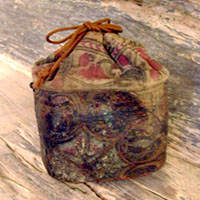
|
|
 |
||
The 10 years from 1880 were the golden age of kinkarakawakami, as this craft of gold-embossed wallpaper came to be known. At the time, Europe had a paper shortage and British ambassador to Japan, Harry Parkes was assigned the task of surveying paper manufacturing in Japan. Parkes's search resulted in the dispatch of a massive batch of Japanese paper samples back to England, among them kinkarakawakami. The product subsequently made a huge hit in Europe. To keep up with demand the Finance Ministry's printing bureau sponsored the craft, taking over all production. This was the start of the craft's golden era. But it was a short-lived one that lasted a mere 10 years, until about the time that the government finally handed over production to the private sector. From this time on -- at the end of the Meiji Era -- machine-made paper started to be used in the craft, resulting in a drop in quality and a subsequent lack of interest from Europe. Before long kinkarakawakami disappeared from the market altogether. |
 |
|
|
|
||
|
How
is it made?
|
||
Restorations around Japan Mr Ueda has been involved in several wallpaper restoration projects until now, including the reception room of the NYK Line Co, Ltd.'s Otaru branch office in Hokkaido (1985), the former Hayashi Home in Okaya City, Nagano Pref. (1991), the Kure Irifuneyama Memorial Pavillion in Kure City, Hiroshima Pref.(1995), Ijohkaku Pavillion in Kobe City, Hyogo Pref. (1999), and the former Iwasaki Home (2002). Of all of these restorations the most interesting is perhaps the pure Japanese hanare (detached room) of the former Hayashi Home in Okaya, itself a precious legacy of the glory years of the early Japanese silk spinning and weaving industry. The gold-embossed wallpaper is applied to a feature wall and the ceiling of the second floor of this structure. It is open to the public and anyone wishing to visit should call the Education Committee of Okaya City at 81- 266-23-4811. |
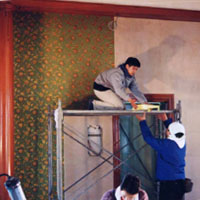 |
|
|
The future (March 2003, Yuko Yokoyama) |
||
|
|
